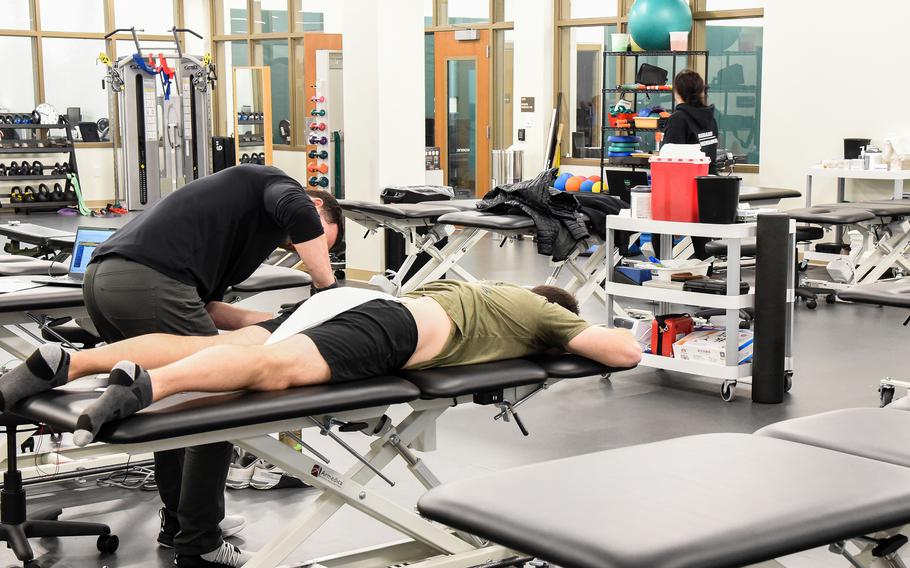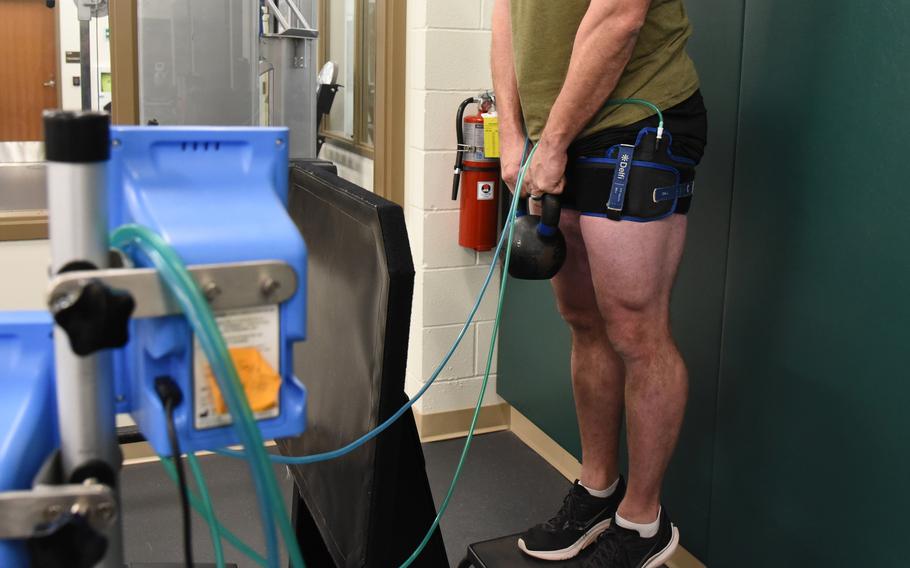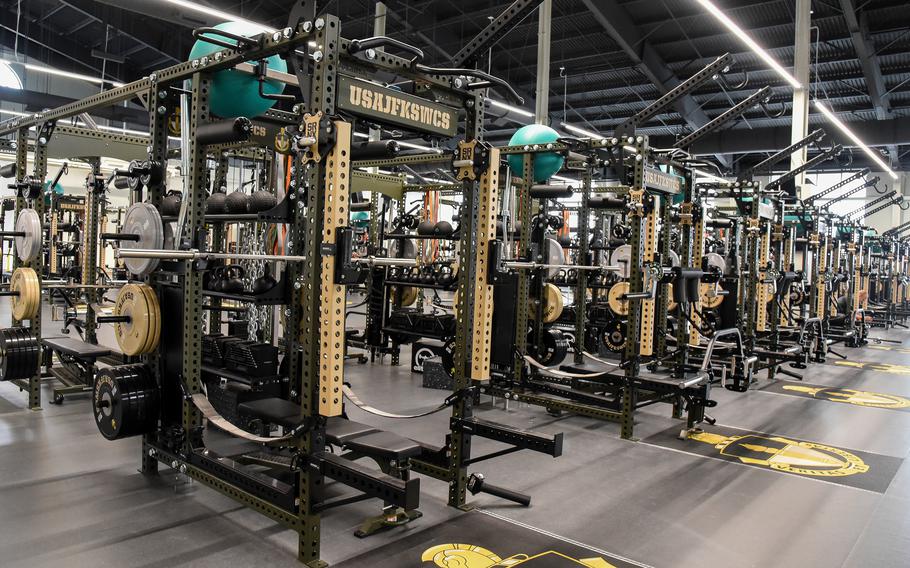
A physical therapist works on a Special Forces soldier at the new Human Performance Force Generation, or HP Forge, facility for the Army’s John F. Kennedy Special Warfare Center and School at Fort Liberty, N.C., on Jan. 23, 2025. The new facility provides more than a dozen physical therapy beds and advanced equipment designed to speed healing for injured troops in the Special Forces training. (Corey Dickstein/Stars and Stripes)
FORT LIBERTY, N.C. — The massive new gym space on Fort Liberty boasts more than 40 weightlifting power racks, state-of-the-art strength and conditioning equipment, an indoor turf field and some 30,000 pounds of weights.
But the $43 million facility is for far more than working out, officials at the Army base said.
“It’s really cool. It’s actually incredible,” Lt. Col. Michael Handlan said as he looked out at the 43,000 square feet of gym space inside the John F. Kennedy Special Warfare Center and School’s new Human Performance Force Generation building on Jan. 23, a day after officials on the North Carolina post officially opened the facility.
Handlan, the Special Forces officer who directs the human performance program for the Special Warfare Center, known as SWCS, said the opening of the 90,000-square-foot building known as HP Forge marks a new step in his program’s efforts to build soldiers best suited for special operations. SWCS is responsible for running the courses that produce Green Berets and psychological operations soldiers. It also provides advanced military education for experienced special operators.
HP Forge “is a place where we have a wide range of human performance and wellness resources housed in one place so that we can synchronize our efforts and provide a holistic approach to training and supporting our service members,” Handlan said.
The human performance program dates back roughly 15 years and was essentially a precursor to the Army’s Holistic Health and Fitness — or H2F — program the service adopted for its conventional forces in 2018.

A special operations soldier uses a blood flow restricting machine in an effort to speed of recovery from a knee injury at the Army’s John F. Kennedy Special Warfare Center and School’s new Human Performance Force Generation, or HP Forge, facility on Fort Liberty on Jan. 23, 2025. (Corey Dickstein/Stars and Stripes)
The program aims to provide its forces with the opportunity to improve their mental, physical and spiritual wellbeing, while also training them in ways that would aid them in completing the grueling courses to enter the Special Forces or psyops fields and on the front lines in combat, Handlan said. HP Forge provides those troops access to strength coaches, physical therapists, mental performance coaches, nutritionists and behavioral health specialists all within the building.
The access to that team of professionals for SWCS soldiers in the training pipelines and the cadre that runs those programs, Handlan said, is the key for ensuring the service produces elite special operators.
“This building, this facility is incredible,” the lieutenant colonel said. “But the resource is the people, the experts that we hire — the people that we bring who are willing to do this … for our folks.”
The human performance program has come a long way since its beginnings a few years into the Global War on Terror, when the command founded the program to focus on rehabilitating soldiers wounded in Iraq and Afghanistan, said Command Sgt. Maj. Lionel Strong, the SWCS senior enlisted leader, who is a Green Beret.
The program began in makeshift gyms — about 500-square-foot repurposed supply rooms, he said. Units within SWCS each had one strength coach and one physical therapist who shared space in those facilities, instead of the large teams of coaches that they have access to now.
“You would literally be tripping over each other working out with one strength coach while the teammate was 10 feet away being worked on by the one and only sole physical therapist,” Strong said. “It’s important to understand where we came from and evolve to where we are.”
The HP Forge facility now includes a physical therapy facility with more than a dozen beds and a host of specialized recovery equipment designed to get injured troops back into the field as quickly and safely as possible, Handlan said. The facility also has digital tools that can help troops understand their physical makeup including muscle and fat tissue and their bone density.
The program seems to be working. Mike Fields, the deputy director of the SWCS human performance program, said the command is gathering data on injury prevention and return to duty times among its population. Recently, SWCS saw 149 of 170 candidates who trained with its human performance program after failing a training stage in the Special Forces pipeline return to their course, often after an injury, and complete it.
“That saves a lot of money,” Fields said. “Horses are not cheap.”

The Army’s John F. Kennedy Special Warfare Center and School at Fort Liberty, N.C., on Jan. 23, 2025 opened a new, 90,000-square-foot holistic health center for its 5,000 some students and cadre, know as the Human Performance Force Generation facility, or HP Forge. The center and school is responsible for training future Green Berets and Army psychological operations soldiers. (Corey Dickstein/Stars and Stripes)
Handlan is also focused on preventing injury and maximizing performance for SWCS’ troops. That includes focusing on proper sleep and proper nutrition — two of the areas that he said SWCS officials have long struggled to convince young soldiers to embrace.
“Getting everyone to buy in on the nutrition and the sleep is really tough,” he said. “What we’re learning is those are the things that ultimately affect us the most significantly long term. If your sleep and your food are horrible for years, no matter what you do in the gym, you’re not going to be able to continue to perform because all the other things are falling off.”
Nutritionists opened a “performance kitchen” in the HP Forge facility where they are focused on providing troops with knowledge about food and the tools to prepare it properly.
“Our dietitians are teaching people how to fuel with the right things at the right time to perform at max level on the objective,” he said. “So, if you’re carrying a ruck for 12 hours through the woods and you know you’re getting ready to hit an objective at [3 a.m.], it’s when do I need the fuel so that my body and my mind are functioning in the right place?”
SWCS has long been great at physically training its soldiers, Handlan said, but its coaches are really working now to develop proper lifestyle habits the troops can adopt for their entire careers.
Another aspect of the human performance program is designed to set baseline understandings of troops’ bodies, which can be measured as they progress forward in their careers, Handlan said.
For Special Forces hopefuls, that process starts when they arrive at SWCS before going into the Green Beret qualification pipeline, he said. Officials gather metrics on every new soldier coming into the command, including identifying muscle imbalances or other musculoskeletal issues that have long plagued soldiers in strenuous physical training programs.
“If we can identify that you are weaker on your left shoulder or your ratio of strength on your left side versus right side is off balance, then we can come up with a dedicated program to fix that [before beginning] training so that you are more successful in your effort to get through an [assessment and selection] program and through a qualification course,” Handlan said.
.jpg/alternates/LANDSCAPE_910/XXXX%20HUMAN%20PERFORMANCE%20photo%2003%202.jpg)
A soldier assigned to the Army’s John F. Kennedy Special Warfare Center and School works out in its new 90,000 holistic health and fitness center know as the Human Performance Force Generation facility, or HP Forge, on Jan. 23, 2025. The new center houses a 43,000-square-foot gym and access to physical therapists, nutritionists, behavioral health specialists and mental coaches. (Corey Dickstein/Stars and Stripes)
For the Green Beret community, those early efforts at SWCS mean more Special Forces troops getting to units, he said. The program’s success has meant producing each year an extra five or more operational detachments — the 12-person Green Beret teams that form the base of Special Forces units, Handlan said.
Strong credited the human performance program with improving what the special warfare school can accomplish with its students, and he said the holistic health approaches that they learn at that early stage of their special operations careers should set a baseline for them as they move forward in the Army and even after they leave the military.
“We want to meet them where we’re at, and we want to optimize their potential across these physical, mental, spiritual, and emotional domains throughout their career,” the command sergeant major said. “And on the other side of that service, whether it’s a five-year career or 20-year career, we want to push a healthy veteran back into society.”